

(Gestures of double hands or combined hands)

ANJALISCHA KAPOTASCHA
KARKATAH SWASTIKASTATHA
KATAKAVARDHAMANASCHA
UTSANGO NISHEDHASTATHA
DOLAH PUSHPAPUTASCHAIVA
TATHA MAKARA EVA CHA
GAJADANTO VAHITTHASCHA
VARDHAMANASTATHIVA CHA
ETE TU SAMYUTA HASTA MAYA
PROKTASTRAYODASHA

There are 13 types of Samyuta Hastas. They are :



 |
|
 PUNASCHA SAMYUTAN HASTAN PUNASCHA SAMYUTAN HASTAN
GADATO ME NIBODHATA
PATAKABHYAM TU HASTABHYAM
SAMSLESHADANJALIH SMRUTAHA |

If two Pataka hands are joined together, it is called Anjali.

It is held above the head for Gods, in front of the fore head for Guru and in front of the chest for Brahmin and scholars.
muggu



 |
|
 ANGULYO YASYA HASTASYA ANGULYO YASYA HASTASYA
ANYONYANTARANI SMRUTAHA
SA KARKATA ITI GNEAHA KARAH
KARMA CHA VAKSYATE |

When the fingers of the hands are interlocked, it is called Karkata.

Bee’s wax, massaging of the limbs, yawning soon after getting up from sleep, supporting the chin, pulling down a branch etc.



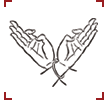 |
|
 MANIBANDHANAVINYASTAU MANIBANDHANAVINYASTAU
ARALOU VARDHAMANAKAU
UTTANAU VAMAPARSHVASTHAU
SWASTIKAH PARIKEERTITAHA |

When the two Arala hands are crossed at their wrist pointing upwards and kept at their left side, it is called Swastika.

Clouds, the sky, forests, seas, seasons, the earth etc.



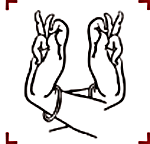 |
|
 KATAKAH KATAKAIRNYASTAHA KATAKAH KATAKAIRNYASTAHA
KATAKAU VARMANAKAHA
SRINGARARTHESHU YOKTAVYAHA
PRAMANAKARANE TATHA |

When two Katakamukha hands are crossed at their wrist, it is called Kataka Vardhamanaka.

To show Sringara, bowing down to person etc.



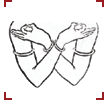 |
|
 ARALAU TU VIPARYASTAU ARALAU TU VIPARYASTAU
UTTANAVURDHVANATAU
UTSANGA ITI VIGNEYAHA
SPARSHASYA GRAHANE KARAHA
|

When both the Arala hands are crossed and lifted up, it is called Utsanga.

Feeling of touch, anger, jealous etc.



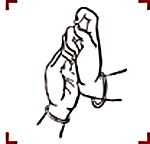 |
|
 SA CHAPI DAKSHINO HASTAHA SA CHAPI DAKSHINO HASTAHA
SAMYAND MUSHTIKRITO BHAVET
ITYESHA NISHADHO HASTAHA
KARMA CHASYA NIBODHATA |

When the left hand in Mukula, covered with the right hand in Mushti, it is called Nishadha.

Patience, intoxication, arrogance etc.



 |
|
 YASTU SARPASIRAH PROKTAHA YASTU SARPASIRAH PROKTAHA
TASYANGULI NIRANTARAHA
DVITYAH PARSVASUSLISHTAHA
SA TU PUSHPAPUTAH SMRUTAHA |

When two Sarpasirsa hands with the fingers close to one another meet on one side intimately, it is called Pushpaputa.

To indicate the receiving or carrying of rice, fruits, flowers and the taking or removing of water.



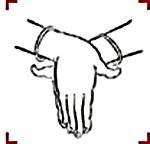 |
|
 PATAKAU TU YADA HASTAU PATAKAU TU YADA HASTAU
MURDHVANGUSHTAVADHO MUKHAU
UPARYUPARI VINYASTAU TADA
SA MAKARAH KARAHA |

Two Pataka hands are turned down and placed on each other with the thumbs kept raised. It is called Makara.

Fish, crocodile etc.



 |
|
 KURPARASANCHITAU HASTAU KURPARASANCHITAU HASTAU
YADASTANAM SARPASIRSHAKAU
GAJADANTAH SA VIGNEYAHA
KARMA CHASA NIBODHATA |

When the two Sarpasirsa hands are placed just above the elbow, it is called Gajadanto.

The carrying of the bride and the groom, excessive weight, clasping a pillar etc.



 |
|
 SUKATUNDAU KARAU KRUTVA SUKATUNDAU KARAU KRUTVA
VAKSHASYABHIMUKHANCHITAU
SANAIRADHOMUKHAVIDHAU
SOVAHITTHA ITI SMRUTAHA |

When two Sukatunda hands meet each other on the chest and are bent and slowly lowered, it is called Avahittha.

Weakness, sigh, revelation of one’s own body etc.



 |
|
 VIGNEYO VARDHAMANASTU VIGNEYO VARDHAMANASTU
HAMSAPAKSAHU PARANMUKHAU
JALAVATAYANADEENAM
PRAYOKTAVYO VIGHATONE
|

When the both Hamsapaksa hands are crossed at the wrist, it is called Vardhamana.

Opening the windows, doors etc.

![]()
![]()
![]()
![]()














